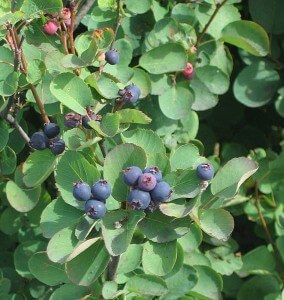
Why are wild fruits so Tasty? It all comes down to evolution. Plants evolved to make their fruit appealing to humans, because if we eat them then we spread their seeds, and humans evolved to enjoy such a nutritious snack, because it improves our health. The Amelanchier( Genus: Amelanchier ), more commonly known by many names such as June Berry, Service Berry, Shadblow Berry, Shadbush Berry, Saskatoon Berry is a hardy edible plant, found wild and cultivated for ornamental use. Different Species thrive in different parts of the United States and Canada, covering most of North America, Which is its native range.
Edibility and Culinary Use

The berries of Amelanchier are edible and ripen in mid summer. They taste similar to blueberries and can be eaten many ways. They are delicious raw and even after eating many berries there is no unpleasant aftertaste. They can also be used in pies and jams. Here is a recipe for Amelanchier Muffins. The Saskatoon Berry( Amelanchier alnifolia ) is a traditional Native American food used in the making of Pemmican which is a high calorie food that preserves well for long journeys. The leaves were also sometimes used to make tea.
Health Benefits
Amelanchier is a very nutritious plant for two primary reasons. One reason is that it contains many different vitamins and minerals, some in relatively high concentrations, to help reach your recommended daily values. It’s like a natural Daily Vitamin pill. Some of the vitamins, minerals, and nutrients it contains include: Dietary Fiber, Riboflavin, Manganese, Calcium, Magnesium, Iron, Vitamin C, Vitamin E, Biotin, and others. The second reason Amelanchier is considered to be healthy is that it contains polyphenol antioxidants similar to blueberries and a number of other fruits.
Plant Health Care

If you have an Amelanchier planted or plan to plant one be cautious of one fungus that is easy to control. There is a fungus that attacks the leaves and fruit and makes the plant useless but the fungus also requires a juniper (including eastern red cedar) as a secondary host. Amelanchier will not do well planted anywhere near a juniper, but other than that issue it does not have many health concerns since it is a native plant.
Conclusion
There are a number of Amelanchier species and most of them can be identified by their low growth habit, no more then 20’ typically, smooth bark, pointed buds, and blueberry like fruits. Considering all the benefits of Amelanchier it is good to know that this plant is finally beginning to show up in the commercial food industry. Depending on what part of the country you live in, Amelanchier may be hard to find in the wild, but there are many species and cultivars available for purchase. Give this plant a try, its health benefits have been known by native people for thousands of years. Finally we have the technology to teach and reintroduce this fruit to people who didn’t know it existed.

Many of our readers find that subscribing to Eat The Planet is the best way to make sure they don't miss any of our valuable information about wild edibles.
See our privacy policy for more information about ads on this site







3 Responses
Where can I buy these berries? I live in Shepherdsville, Ky
Your article implies that the plant has the ability to think and solve problems like how to make itself taste better. The simple and straightforward answer is the plant was created to taste great so that those humans that were also created would enjoy them.
Dear god, do you in your spare time Google ‘Evolution’ and put comments in every Website you find?